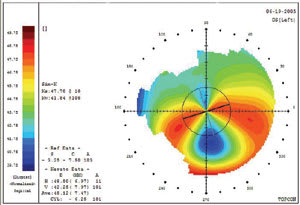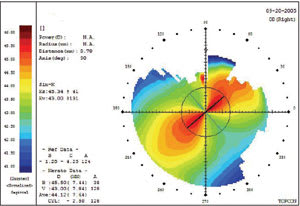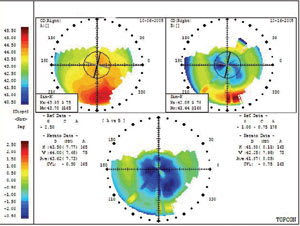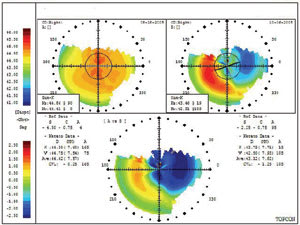CORNEAL TOPOGRAPHY
Is Your Practice Ready for a Corneal Topographer
A corneal topographer can help advance your
lens practice with custom fits, corneal reshaping and more.
By Dianne M. Anderson, OD
|
|

|

|
|
Figure 1.(top) Oval Keratoconus (middle) Pellucid
Marginal Degeneration, (bottom) Oblique Astigmatism. It is difficult to determine the
diagnosis with refraction and |
Corneal topography plays an integral part in the decision-making process when managing challenging contact lens fits as well as in the diagnosis and management of corneal disorders.
Without topography, choices are limited to ordering and dispensing numerous pairs of diagnostic contact lenses or attempting to refer the patient to another practice. This can be time-consuming for both practitioner and patient. And the results may be less than favorable if the patient chooses not to return to your practice. Your decision to purchase a topographer should be motivated by the desire to provide patients with the most comprehensive eye care possible — as well as the desire to expand your knowledge and fitting skills with specialty contact lens designs.
Access to topography also opens up the world of corneal reshaping or orthokeratology. The return on investment with corneal reshaping can be spectacular, and so can patient satisfaction.
Many people view this modality as an attractive alternative to LASIK. And because the FDA has placed no age restriction on corneal reshaping, it's a great alternative to glasses or daytime contact lenses for adolescents.
The future of corneal reshaping also looks promising as new lens designs such as hyperopic/presbyopic, toric and possibly hybrid lenses come to market. Ongoing research shows the potential for myopia control with corneal reshaping. So there's great promise for both practitioner and consumer that this modality may establish future trends in correcting refractive errors with contact lenses.
Evaluating Your Lens Practice
The decision to purchase a corneal topographer is very individualized. What is imperative to one practitioner may be meaningless to another. If you fit into one or more of the following scenarios, a topographer could be a significant asset to your practice.
You refer patients to other practices for topography. If questionable astigmatic refractions and irregular keratometry mires send you directly to the referral pad, think again. You could be servicing these patients with your own topographer.
Patients will be impressed with the technology and convenience. You can collect the service fee and proceed to schedule the patient for a specialty lens fitting. Keep in mind that referring patients out may give them the impression that you're not fully capable of meeting their needs.
You enjoy working with GPs such as keratoconic and toric designs. These specialty GPs are best fit via diagnostic lenses from fitting sets. The initial diagnostic lens choice is best calculated from evaluation of corneal topography. It's helpful to know if the patient has keratoconus, pellucid marginal degeneration (PMD) or highly oblique astigmatism (Figure 1). The dynamics of the GP will be more physiologically compliant with the underlying cornea if you consider the peripheral contours of the cornea. Many new GP designs allow unique manipulations of the optic zone, peripheral curves and eccentricity to customize the fit for improved visual performance and comfort.
You manage difficult astigmatic soft contact lens fits. Some astigmatic refractions give great results with spectacles, but unsatisfactory results with soft toric lenses. Corneal topography can reveal some reasons for this trouble. The astigmatism may be irregular, oblique, lenticular or limbal-to-limbal (Figure 2). These cases may require custom toric, soft lens designs. Accurate measurement of HVID with the topographer is key to successful lens diameter and base curve selection.
|
|
|
Figure 2. Limbal-to-limbal astigmatism. These patients can experience poor quality of vision with standard lens designs. Spectacle correction, however, is usually excellent. |
You rehabilitate patients who have contact lens-induced corneal warpage. Many patients overextend the life of their soft lenses or wear traditional hydrogels on a continuous schedule. Some are wearing tight lenses. GP wearers can be guilty of overwear and excessive protein deposits, or may be wearing old, poorly fit lenses. The result may be transient visual impairment secondary to corneal edema and warpage. This usually presents as a significant change in the refractive astigmatism that correlates to a significant change in corneal astigmatism.
The practitioner may find irregular keratometry mires which make it difficult to differentiate corneal warpage from early keratoconus. However, you can better evaluate the problem from a topographic map.
Discontinuing lens wear and repeating topography in three to four weeks may show a significant difference map (Figure 3). These maps are an impressive way to explain this problem and prevent its recurrence.
You have an interest in corneal reshaping. With advanced lens designs and solid FDA results on file, the time is ripe to expand your services to include corneal reshaping. There is a great potential for patient retention and profit within this specialty. However, there's also a great deal of apprehension linked to this decision. The initial investment required may seem overwhelming and you may have questions about your potential success with soliciting patients or with your clinical fitting skills.
|
|
| Figure 3. Difference map of lens-induced corneal warpage. Notice the change in corneal appearance and refraction over three weeks time. This patient had been wearing a large diameter, tight-fitting soft toric lens. |
Becoming certified in corneal reshaping is straightforward. And learning the dynamics of reverse-geometry lenses will set you apart from the average contact lens practitioner. Certification courses cost nothing but a few hours of well-spent time.
Because there are now several corneal reshaping lenses on the market, choosing the designs to fit can also be overwhelming. Consulting with the vendors and distributing labs of corneal reshaping lenses will help you choose the designs that will best fit into your practice.
Your patients are inquiring about LASIK. If you're in a successful contact lens practice, rarely will a day go by without several patients inquiring about their candidacy for LASIK. You may be prepared to answer their questions or to refer them out for further evaluation.
With a topographer, you are able to begin the LASIK evaluation in your office. There may be some interesting, unexpected patterns on the topography map that could disqualify the patient. Even if the topography map shows everything is normal, the patient may wish to try corneal reshaping as a safer alternative to LASIK.
Choosing a Topographer
|
|
|
|

|
| Figure 4. (top) Paragon CRT Images. Inferior decentered lens needs reduced LZA, (middle) laterally decentered lens needs increased RZD (bottom) well-centered CRT lens |
There are numerous manufacturers and models of topographers. Basic features include axial and refractive maps, tangential maps, difference or subtractive maps,
elevation maps and contact lens fitting analysis. More advanced features include video imaging, detailed map analysis and/or Zernike analysis/wavefront aberrometry. Some models combine autorefraction and keratometry with corneal mapping software. Combined features may be a good choice if you're just getting started with topography and don't own an autorefractor or autokeratometer. These models save space, and perform the duties of three instruments in one.
Each model differs in the quality and detail of images produced. Models with high resolution, numerous rings and large number of data points will generate more detailed maps. Some topography-based ortho-k designs require a topographer with high resolution capabilities for precise measurements of apical radius, sagittal depth and HVID. Prices vary according to features and detail. Some manufacturers price their topographers with or without the required laptop or desktop computer. You may need additional software to perform functions such as ortho-k predictability and specific GP lens design. It's also important that you understand the applications and limitations of the different models before you make a decision.
You can also gather more information from the manufacturer Web sites and instrument buying guides.
Applying Topography to Your Lens Practice
Performing topography saves chair time by allowing you to accurately diagnose corneal disorders and efficiently fit or design the appropriate contact lenses for each patient. In each case, the best treatment is determined by diagnosis, patient needs and lenses available to best meet those needs (Table 1).
It's imperative to perform topography on patients undergoing corneal reshaping. A baseline map is saved and used as a comparison to monitor the patient's progress. Difference maps are helpful in determining which changes in lens parameters, if any, are necessary (Figure 4).
Axial or refractive maps help you monitor refractive changes and tangential maps help determine the orientation of those changes on the cornea.
Summary
Utilizing corneal topography to its full potential can advance your fitting skills and success with a variety of specialty contact lens designs. The right combination of instruments and self-motivation will have you well on your way to creating a profitable and rewarding specialty contact lens practice.
To obtain references for this article, please visit http://www.clspectrum.com/references.asp and click on document #129.
Dr. Anderson is a graduate of Indiana University School of Optometry. She practices in the western suburbs of Chicago, specializing in orthokeratology, keratoconus and post-surgical lens fits and anterior segment disease. She may be reached at Dianne.Anderson@comcast.net
|
TABLE 1 |
|
Applicable
Diagnostic and Procedural Codes ICD -9 CODES 367.22 Irregular Astigmatism
CPT CODES 92015 Refraction, Refractive Visit CONTACT LENS MATERIALS |
Internet Resources
Paragoncrt.com. User-friendly online CRT tutorial and certification exam. Offers monthly online interactive Web seminars, numerous practice-management guidelines available.
BERetainer.com. This site provides a detailed explanation of topography features needed to successfully fit this version of Bausch & Lomb's Vision Shaping Treatment (VST). Access articles on pre- and post-fitting topography analysis. VST and BE Retainer certification available online.
SynergEyes.com. Detailed, interactive site geared toward informing practitioners and patients about this new family of hybrid lenses.
Clspectrum.com. Use the keywords "corneal topography" to access a wealth of archived articles on various applications of topography.
Contemporary Orthokeratology — This is an ortho-k overview written by Ed Bennett, OD, MSEd. Listed under Vision Care CE on clspectrum.com. COPE-approved for 1 credit hour.








